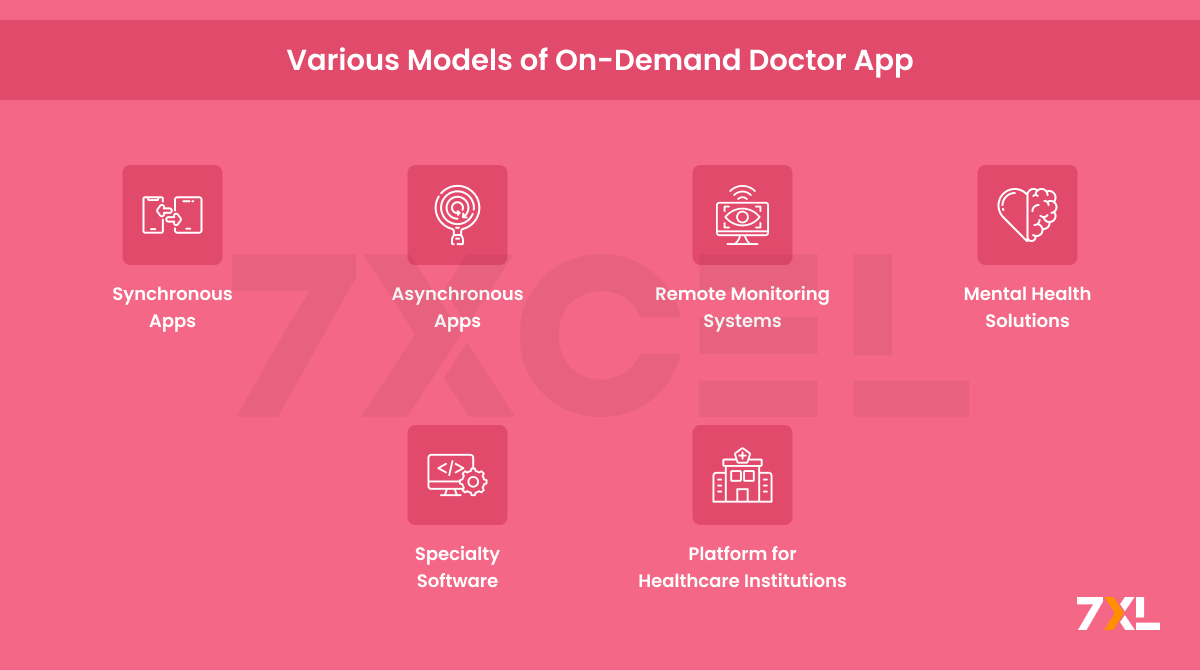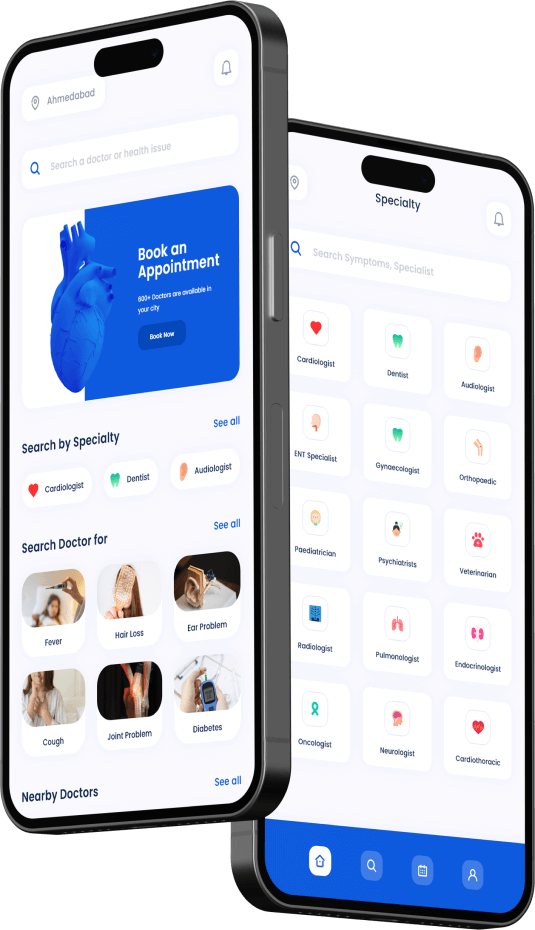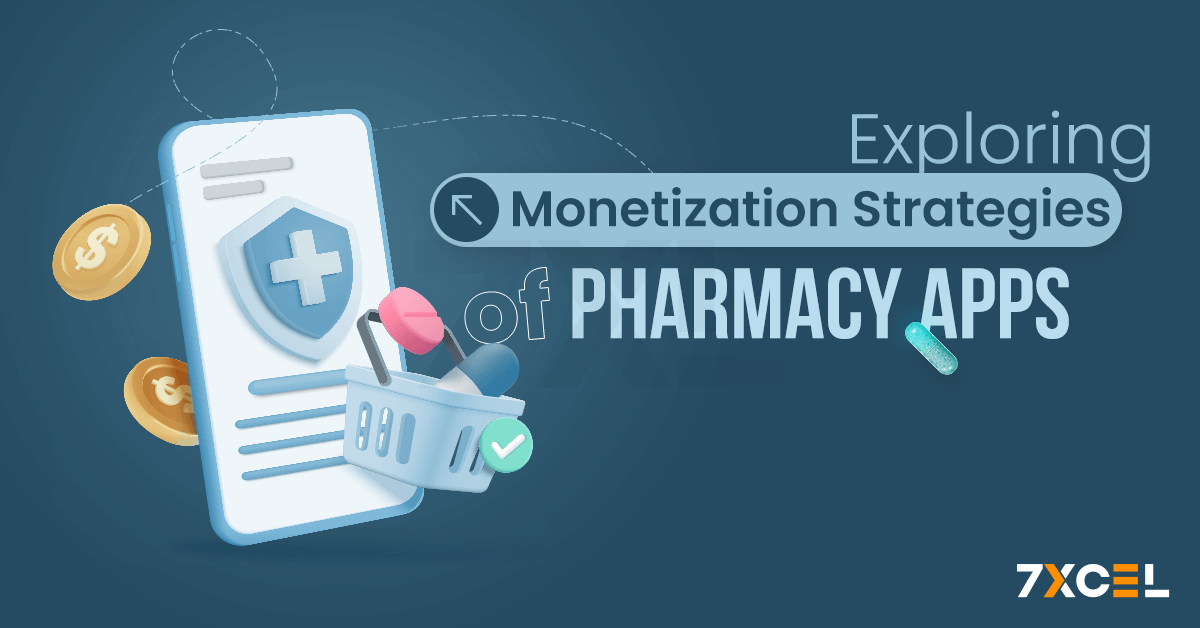Quick Summary:
What features an on-demand doctor app should have by 2024: find out what all the vital elements are, from virtual consultations and EHR integration to advanced AI analytics and compliance with healthcare regulations, bringing improvement for patient outcomes and the betterment of healthcare delivery. Read on to discover the feature of on-demand doctor applications!
In 2024, the healthcare industry is poised for massive digital transformation, with on-demand doctor apps at the forefront of this evolution. Valued at $87.41 billion in 2022, the market for these apps is projected to reach $286.22 billion by 2030 – as per report. This growth is driven by the increasing demand for remote health services, technological advancements, and the need to address disparities in healthcare access.
Market research shows that both patients and healthcare providers are increasingly adopting telehealth solutions. According to Statista, revenues from online doctor consultations are expected to surpass $23 billion by 2024. Additionally, a report from McKinsey & Company highlights a 38% increase in telemedicine usage, emphasizing the lasting impact of the COVID-19 pandemic on patient behavior towards telehealth services.
To meet these competitive demands, developers must incorporate both basic and advanced functionalities into their apps, utilizing current technologies and ensuring regulatory compliance. This approach not only enhances patient care but also streamlines healthcare delivery, making the practice more efficient and cost-effective.
Trends in the Healthcare App Market for 2024
With the development of technology and changing patient demands, the healthcare app industry is expected to undergo substantial expansion and change by 2024. Here are some key trends to watch:

1. Artificial Intelligence (AI) and Machine Learning (ML)
AI and ML are revolutionizing healthcare by enabling predictive analytics, personalized medicine, and improved diagnostic accuracy. With the use of these technologies, big datasets may be analyzed to find trends and forecast health problems, facilitating earlier intervention and improved chronic illness management. AI-powered chatbots and virtual assistants enhance patient interactions, offering instant support and streamlined appointment scheduling.
2. Telemedicine and Remote Patient Monitoring (RPM)
Telemedicine continues to grow, offering convenience and flexibility in healthcare delivery. RPM technologies allow for continuous monitoring of patients’ health conditions, making it easier to manage chronic diseases and reduce hospital readmissions. These technologies have proven particularly useful in remote areas where access to healthcare is limited.
3. Cloud Computing
Because cloud computing offers secure and scalable data storage options, its use in the healthcare industry is growing. Cloud-based healthcare apps enable real-time access to patient records, billing information, and insurance plans from anywhere, improving efficiency and collaboration between healthcare providers.
4. Big Data Analytics
Big data analytics is becoming integral to healthcare, helping providers deliver value-based, patient-centric care. It aids in disease prevention, predicting epidemics, and improving overall quality of care by providing deep insights into patient data and healthcare trends.
5. Extended Reality (XR)
There are several applications for extended reality, such as remote rehabilitation, specialized treatments, and medical education. AR and VR are examples of extended reality. These technologies create immersive simulations for training and therapy, enhancing the skills of healthcare professionals and the recovery experiences of patients.
6. Internet of Things (IoT)
Smart medical equipment and wearable health monitors are examples of IoT gadgets that are being incorporated into healthcare apps to offer real-time data analysis and ongoing health tracking. This integration supports proactive healthcare management and improves patient outcomes by allowing for immediate medical interventions based on real-time data.
7. Data Security and Compliance
Regulation compliance and data security are more important than ever with the growing usage of digital health solutions. Healthy relationships between patients and healthcare providers are fostered by adhering to laws like GDPR and HIPAA, which safeguard patient data from security breaches.
The demands of patients and healthcare professionals are always changing, and developers of healthcare apps can respond to these needs by developing creative, practical, and user-friendly solutions.
How Do These Features Benefit Patients and Healthcare Providers?
On-demand doctor apps provide a way to increase patient convenience, lower costs, and improve health outcomes. It makes the provider’s schedule flexible, offers better work-life balance, and an efficient workflow with features such as EHR integration, real-time analytics, patient engagement, and data management secured in line with regulatory compliance:

Convenience
On-demand doctor apps eliminate travel costs, and healthcare can be availed from any place. Virtual consultations save time and also reduce the hassle of visiting a clinic. Easy appointment scheduling is another benefit of easy availability.
Reduced Costs
These apps contribute to a reduction in healthcare costs, reducing the number of unnecessary emergency room visits and in-person consultations. From the patient’s side, they receive appropriate advice and treatment promptly, and it is possible from a location that turns out to be cost-effective.
Improved Patient Outcomes
Continuous health monitoring and 24/7 access to healthcare professionals allow for the effective management of health. Features such as medication reminders and integration into the EHR help ensure patients are compliant with their treatment plans, thereby receiving personal help for improved health.
Better Work-Life Balance for Doctors
For healthcare providers, on-demand apps provide flexibility. Doctors can better plan their time, which dramatically decreases stress compared to the stringent office hour system. Such a measure allows them to attain a balance of life, which could further improve job satisfaction and performance.
Enhanced Patient Engagement
Real-time analytics and document-sharing features would make the process of communication between patients and providers better. The patient feels that they are a part of their care, which increases satisfaction and treatment adherence.
Regulatory Compliance
Policy compliance, for example, with healthcare laws and regulations such as HIPAA and GDPR, ensures that patient privacy is taken care of and personal health information is secured. Therefore, trust is built among patients and providers that their data is secure.
On the integration of these on-demand doctor app features can take the healthcare experience for patients and doctors several notches higher, delivering efficiency, satisfaction, and superior health outcomes. This, therefore, ensures smooth interaction, better for everyone who interacts or participates in the health care system.
Models of On-Demand Doctor App
The cost of developing on-demand doctor apps has also evolved based on various models that can cater to the diverse health needs. Such models leverage the various existing technologies to provide practical, accessible, and specialized healthcare. This evolution ensures that different wide-ranging health requirements are met effectively.

Synchronous Apps
Synchronous apps allow real-time communication between patients and healthcare service providers. Such apps comprise video consultations, live chats, and instant feedback features. The evidence base seems to support the view that synchronous communication allows patients to get timely medical advice and appropriate diagnoses, better suiting urgent care and quick consultations.
Benefits
- Real-Time Consultation: Gives patients instant medical advice and consultations.
- Improved Patient-Doctor Interaction: Visual and verbal communications help better in diagnosis.
- Early Interventions: Good for urgent medical needs and follow-ups; provides timely attention and care.
Asynchronous Apps
On the other hand, asynchronous applications enable communication between the patient and health clinician at different times. Patients can send any form of media to explain, for example, symptoms that describe the condition, and then the doctors see and react to it at a different time. That best applies to consultations and follow-up treatments that do not need an urgent response.
Benefits
- Flexibility: Patients and doctors can communicate whenever they want.
- Documentation: Communication is documented, thus, it will provide a record for future reference.
- Efficiency: Eliminates the need for real-time scheduling and allows physicians to better manage their time.
Remote Monitoring Systems
These systems can continuously track the health metrics of patients through the use of wearable devices. Such systems are best implemented for treating chronic diseases and for postoperative care. Data collected in devices like heart rate monitors, glucose meters, and blood pressure cuffs is transmitted to the health providers for continuous monitoring.
Benefits
- Continuous Monitoring: Real-time health parameters, which provide opportunities for proactive care.
- Chronic Disease Management: Helps manage conditions such as diabetes, hypertension, and heart disease.
- Reduced Hospital Visits: This means that if hospital visits were required, the duration and number of visits would drastically reduce, hence saving on time
Mental Health Solutions
Mental health solutions within on-demand doctor apps cater specifically to psychological and psychiatric care. These apps offer features such as virtual therapy sessions, mood tracking, and mental health assessments. The convenience of accessing mental health services remotely encourages more individuals to seek help.
Benefits
- Accessibility: Makes mental health care accessible to those who may be hesitant to visit a therapist in person.
- Anonymity: Equips a sense of privacy & security, reducing stigma.
- Continuity of Care: Allows for regular monitoring and follow-up sessions.
Specialty Software
Specialty software is designed to address the unique requirements of different medical specialties, including orthopedics, cardiology, and dermatology. These apps offer resources and tools specific to each area, such as patient education materials, treatment regimens, and specialized diagnostic tools.
Benefits
- Tailored Solutions: Offers specialized features that cater to specific medical fields.
- Improved Diagnostics: Utilizes specialized tools for more accurate diagnosis and treatment.
- Educational Resources: Provides patients with information and resources related to their specific conditions.
Platform for Healthcare Institutions
Platforms designed for healthcare institutions integrate various services to provide comprehensive care. These platforms support features such as appointment scheduling, patient management, billing, and EHR integration. They are used by hospitals, clinics, and other healthcare facilities to streamline operations and improve patient care.
Benefits
- Integrated Services: Combines multiple services into one platform, improving efficiency.
- Scalability: Suitable for large healthcare institutions with diverse needs.
- Enhanced Patient Care: Streamlines processes, allowing healthcare providers to focus more on patient care.
By understanding and leveraging these different models, healthcare providers can select the most appropriate solutions to meet the patients needs and improve overall healthcare delivery.

Planning to Develop an On-Demand Doctor App?
Build your cutting-edge doctor app with 7xcel – quicker, simpler, and packed with features that enhance patient care.
Features of On-Demand Doctor Application
To create a truly competitive and user-friendly on-demand doctor app, developers must incorporate a variety of advanced features. These features improve the functionality of the app, ensure compliance with healthcare regulations, and improve the overall patient and provider experience.

E-Prescribing and Medication Mailing
E-Prescribing: Allows doctors to send prescriptions directly to pharmacies electronically, reducing errors and improving efficiency. By doing away with the requirement for paper prescriptions, this feature improves efficiency for both patients and healthcare professionals.
Medication Mailing: This feature allows pharmacies to mail medications directly to patients’ homes, ensuring timely and convenient access to prescribed drugs. It also helps patients adhere to their treatment plans by making medication access easier .
Treatment Management
This feature helps in organizing and managing patient treatments by enabling healthcare providers to monitor progress, make necessary adjustments, and provide comprehensive care plans. It ensures continuity of care and helps in tracking the effectiveness of treatments over time.
In-App Billing
Secure Billing Streamlined and secure billing processes integrated directly within the app facilitate easy payment for services. Patients can view and pay their bills through various methods, including credit/debit cards, digital wallets, and insurance claims, ensuring a hassle-free experience .
Appointment Management
Users can easily schedule, reschedule, and cancel appointments within the app. Real-time updates and reminders help in reducing no-shows and ensuring timely consultations, thus enhancing the efficiency of healthcare delivery.
Doctor-Patient Communication
In-App Video Calling Secure video calls enable real-time consultations between patients and doctors, fostering better understanding, quicker diagnosis, and effective treatment.
In-App Chat Secure chat features allow patients to communicate with their healthcare providers anytime, facilitating continuous care and quick resolution of queries .
Treatment & Medication Management
This feature allows patients to track their treatment plans and medication schedules within the app. It ensures that patients adhere to their prescribed treatments, improving health outcomes.
Condition Self-Management
Tools and resources within the app empower patients to manage chronic conditions or recovery processes independently. This can include educational content, self-assessment tools, and reminders for medication or lifestyle changes.
Analytics & Reporting
Tools for real-time analytics and reporting offer insightful information on patient data, app usage, and healthcare results. Treatment plans can be customized, resources can be maximized, and services can be improved with the use of these insights.
Billing & Insurance Management
Automated Health Insurance Claims This feature simplifies the insurance verification process, allowing patients to quickly determine coverage for prescribed treatments and medications. It reduces administrative burdens for healthcare providers and ensures that patients have access to necessary care .
Accessibility
It’s imperative to make sure the software is usable by everyone, including people with impairments. Features like voice commands, text-to-speech, and adjustable text sizes make the app more user-friendly. Supporting multiple languages and currencies further enhances its usability for a global audience .
Security & Compliance
Robust security measures, including encryption, secure authentication, and regular compliance updates, are essential to protect patient data and ensure privacy. Adherence to regulations like HIPAA and GDPR builds trust and ensures that the app meets legal requirements .
Sign-Up
A seamless sign-up process and easy-to-navigate interface enhance the user experience from the start. Features like social media logins and biometric authentication can simplify the registration process and ensure security .
Doctor Profile Search
Patients can look for doctors using a variety of parameters, including ratings, specialization, geography, and availability. This feature helps users find and connect with the right healthcare providers quickly and efficiently .
Location Tracking
The app can use GPS to recommend nearby healthcare providers and pharmacies. This ensures timely care and convenience for patients by connecting them with local services .
Record Maintenance
Secure storage and easy sharing of medical records ensure that all relevant information is accessible to both patients and healthcare providers. Integration with EHR systems ensures comprehensive data management and continuity of care .
Payment Integration
Integration with multiple payment gateways allows patients to pay for services using their preferred methods. This includes options like credit/debit cards, digital wallets, and direct insurance billing, ensuring a seamless and secure transaction process .
Review & Ratings
Allowing users to review and rate doctors and services provides valuable feedback and helps maintain high standards of care. This feature can also assist new users in selecting healthcare providers based on previous patient experiences .
Document Sharing
Easy sharing and scanning of medical documents improve patient history comprehension and facilitate better diagnosis and treatment. Patients and doctors can securely exchange lab results, prescriptions, and other vital records within the app .
CMS & CRM Integrations
Content Management Systems (CMS) and Customer Relationship Management (CRM) integrations help in managing content and improving user interactions. These integrations enhance the overall efficiency of the app by providing tools for better content management and user engagement .
EHR Integration
Integrating Electronic Health Record (EHR) systems into on-demand doctor apps allows healthcare providers comprehensive access to patient medical histories, enabling informed decisions and personalized care. This feature, along with others, can significantly enhance care quality, streamline operations, and improve user satisfaction, positioning the app for success in the competitive healthcare market.
How Will Cognitive Technology Enhance On-Demand Doctor Apps?
Cognitive technology, particularly AI and machine learning, significantly enhances the functionality and efficiency of on-demand doctor apps. Partnering with an experienced eLearning App Development Company can help you build a sophisticated platform that incorporates these advanced technologies seamlessly.
These companies bring expertise in automating routine tasks, analyzing large datasets to uncover patterns, and providing personalized health insights, thereby improving patient care and operational efficiency. By leveraging their knowledge, you can create a more effective and user-friendly app that meets the needs of both patients and healthcare providers.

Personalized Treatment Recommendations
AI-driven analytics can offer personalized treatment recommendations by analyzing patient data, predicting potential health issues, and providing insights into patient behavior and health trends. More precise diagnosis and individualized treatment regimens may result from this.
Predictive Analytics
By analyzing historical patient data, AI can predict future health issues, allowing for early intervention and better management of chronic diseases. Predictive analytics can identify patients at risk and recommend preventive measures, improving overall health outcomes.
Natural Language Processing (NLP)
NLP can enhance patient interactions by enabling more intuitive and responsive communication within the app. This can enhance patient satisfaction and engagement since the app can comprehend and reply to natural language requests more efficiently. For example, virtual assistants powered by NLP can guide patients through symptom checkers or provide answers to common medical questions.
Automated Customer Support
AI-powered chatbots can provide immediate assistance to patients, answering common questions and guiding them through the app. This improves the user experience by providing instant support and reducing wait times. Chatbots can also help with appointment scheduling, medication reminders, and other administrative tasks.
Machine Learning for Diagnostics
Precision Medical photos, test results, and other diagnostic data can be analyzed by machine learning algorithms to find trends and abnormalities that human practitioners would overlook. This may result in earlier illness detection and more precise diagnosis.
Virtual Health Assistants
Virtual health assistants can monitor patients’ health metrics in real-time, providing reminders for medication, exercise, and dietary recommendations. These assistants can also alert healthcare providers if any concerning changes are detected, enabling timely interventions.
Data Analytics and Insights
Tools for real-time analytics and reporting offer insightful information on patient data, app usage, and healthcare results. Treatment plans can be customized, resources can be maximized, and services can be improved with the use of these insights. Analytics, for instance, can spot patterns in patient behavior and assist doctors in modifying their approaches to care.
Security and Compliance
AI can significantly enhance security in on-demand medical apps by detecting and addressing potential threats through machine learning algorithms that identify unusual behavior patterns. Additionally, AI helps maintain compliance with healthcare regulations by automating documentation and audit processes. Integrating cognitive technology into these apps not only improves usability and functionality but also ensures they meet the evolving needs of both patients and healthcare providers while staying current with emerging technologies and legal requirements.
Conclusion
In 2024, on-demand doctor apps will revolutionize healthcare with essential features like virtual consultations and EHR integration. Advanced AI, automated health insurance claims, and cloud computing enhance efficiency and personalization, ensuring competitive edge and improved patient outcomes in the healthcare market.








